
Sports car racing is a form of motorsport road racing which utilises sports cars that have two seats and enclosed wheels. They may be either purpose-built sports prototypes which are the highest level in sports car racing or grand tourers based on road-going models and therefore, in general, not as fast as sports prototypes. Sports car racing is one of the main types of circuit auto racing, alongside open-wheel racing, touring car racing and stock car racing. Sports car races are often, though not always, endurance races that are run over particularly long distances or large amounts of time, resulting in a larger emphasis on the reliability and efficiency of the car and its drivers as opposed to outright car performance or driver skills. The FIA World Endurance Championship is an example of one of the best known sports car racing series.

Endurance racing is a form of motorsport racing which is meant to test the durability of equipment and endurance of participants. Teams of multiple drivers attempt to cover a large distance in a single event, with participants given a break with the ability to change during the race. Endurance races can be run either to cover a set distance in laps as quickly as possible, or to cover as much distance as possible over a preset amount of time.
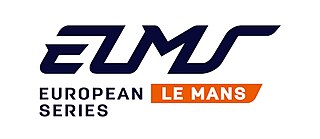
The European Le Mans Series is a European sports car racing endurance series inspired by the 24 Hours of Le Mans race and organized by the Automobile Club de l'Ouest (ACO). The European Le Mans Series is similar to the former American Le Mans Series (ALMS) based in the United States and Canada that was running with ACO and IMSA between 1999 and 2013. ELMS team champions and runners-up receive an automatic entry to the following year's 24 Hours of Le Mans. Originally titled the Le Mans Endurance Series before becoming simply the Le Mans Series in 2006, the series was renamed once more in 2012, reusing a name previously utilized by IMSA in 2001.

A Le Mans Prototype (LMP) is a type of sports prototype race car used in various races and championships, including the 24 Hours of Le Mans, FIA World Endurance Championship, IMSA SportsCar Championship, European Le Mans Series, and Asian Le Mans Series. Le Mans Prototypes were created by the Automobile Club de l'Ouest (ACO). The technical requirements for an LMP include bodywork covering all mechanical elements of the car. As of 2023, there are two classes within Le Mans Prototypes, designated LMP2 and LMP3.

Group C was a category of sports car racing introduced by the FIA in 1982 and continuing until 1993, with Group A for touring cars and Group B for GTs.
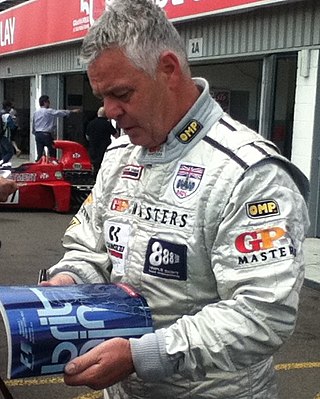
The 1992 Sportscar World Championship season was the 40th and final season of FIA World Sportscar Championship motor racing. It featured the 1992 FIA Sportscar World Championship, which was contested over a six race series which ran from 26 April to 18 October 1992. The championship was open to Group C Sportscars.
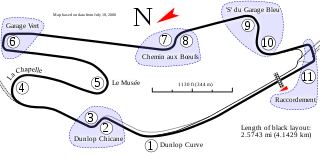
The 2003 1000 km of Le Mans was a one-off sports car event run under the organization of the Automobile Club de l'Ouest (ACO) in preparation for the Le Mans Endurance Series that began in 2004. It was run on 9 November 2003 at the Bugatti Circuit near Le Mans, France.

The 2001 European Le Mans Series season was the only season for the IMSA European Le Mans Series. It is a series for Le Mans Prototypes (LMP) and Grand Touring (GT) race cars divided into 4 classes: LMP900, LMP675, GTS, and GT. It began 17 March 2001 and ended 6 October 2001 after 7 races.

The Japan Le Mans Challenge was an endurance sportscar series based in Japan built around the 24 Hours of Le Mans that began in 2006. It was run by the Sports Car Endurance Race Operation (SERO) sanctioning body and ran under the rules laid out by the Automobile Club de l'Ouest (ACO). It is the first endurance sportscar series in Japan since the demise of the All Japan Sports Prototype Championship in 1992, although the ACO had run a single endurance race since then, the 1999 Le Mans Fuji 1000 km. The series was cancelled in 2007 following two poor seasons.
The FIA Sportscar Championship was a sports car racing series created by John Mangoletsi and got the approval of the Fédération Internationale de l'Automobile (FIA) in 2001. It was a series similar to the FIA GT Championship, concentrating on two classes of open-cockpit sports prototypes in endurance races mostly around Europe. The series was folded after the 2003 season.

The Asian Le Mans Series (AsLMS) is an Asian sports car racing endurance series created by the Automobile Club de l'Ouest (ACO) and based in Asia. It is the successor to the defunct Japan Le Mans Challenge which folded in 2007 after its second season. The ACO aims to attract teams and drivers from Asian countries.
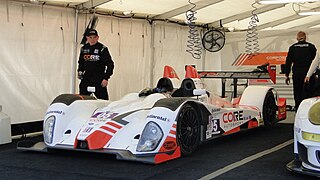
The Le Mans Prototype Challenge was a spec sports prototype formula created by the Automobile Club de l'Ouest (ACO), organisers of the 24 Hours of Le Mans, and sports car constructor Oreca. The formula is intended as part of a ladder system for young and upcoming drivers into the world of endurance racing while also serving as a value engineered entry for drivers and teams into Le Mans Prototypes due to limitations on manufacturers and suppliers.
The Spyker Squadron was the factory racing team from Dutch sportscar manufacturer Spyker Cars. The team raced in various endurance championships and non-championship races from 2002 to 2010. Daily operations were managed by Peter van Erp, the later Spyker Cars COO.

The FIA World Endurance Championship, abbreviated as WEC, is an auto racing world championship organized by the Automobile Club de l'Ouest (ACO) and sanctioned by the Fédération Internationale de l'Automobile (FIA). The series supersedes the ACO's former Intercontinental Le Mans Cup which began in 2010 and is the first endurance series of world championship status since the demise of the World Sportscar Championship at the end of 1992. The World Endurance Championship name was previously used by the FIA from 1981 to 1985.
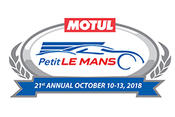
The Petit Le Mans is a sports car endurance race held annually at Road Atlanta in Braselton, Georgia, United States. It has often used the rules established for the 24 Hours of Le Mans by the Automobile Club de l'Ouest (ACO), which are slightly modified if necessary, mainly to allow additional cars to compete.

The IMSA SportsCar Championship, currently known as the IMSA WeatherTech SportsCar Championship under sponsorship, is a sports car racing series based in the United States and Canada and organized by the International Motor Sports Association (IMSA). It is a result of a merger between two existing North American sports car racing series, the American Le Mans Series and Rolex Sports Car Series. At its inception, the name was United SportsCar Championship, which subsequently changed to IMSA SportsCar Championship in 2016. Rolex SA's Tudor brand was the championship's title sponsor in 2014 and 2015, and since 2016 WeatherTech has served as title sponsor.

The 2015 FIA World Endurance Championship season was the fourth season of the FIA World Endurance Championship auto racing series, co-organized by the Fédération Internationale de l'Automobile (FIA) and the Automobile Club de l'Ouest (ACO). The series was open to Le Mans Prototypes and grand tourer-style racing cars meeting four ACO categories. World championship titles were awarded for Le Mans Prototypes drivers and for manufacturers in the LMP1 category, and several World Endurance Cups and Endurance Trophies were also awarded in all four categories. The season began at the Silverstone Circuit in April and ended at the Bahrain International Circuit in November after eight rounds, and included the 83rd running of the 24 Hours of Le Mans.

The 2017 FIA World Endurance Championship was the sixth season of the FIA World Endurance Championship, an auto racing series co-organised by the Fédération Internationale de l'Automobile (FIA) and the Automobile Club de l'Ouest (ACO). The series is open to Le Mans Prototypes and grand tourer-style racing cars divided into four categories. The season began at the Silverstone Circuit in April and will end at the Bahrain International Circuit in November, and include the 85th running of the 24 Hours of Le Mans. World championship titles will be awarded to the leading prototype drivers and manufacturers, while for the first time in the World Endurance Championship the leading grand touring drivers and manufacturers will also be awarded a world championship.

Group GT1, also known simply as GT1, was a set of regulations maintained formerly by the Fédération Internationale de l'Automobile (FIA), for Grand Tourer racing. The category was first created in 1993, as the top class of the BPR Global GT Series, and was included in the 24 Hours of Le Mans. It fell under FIA regulation from 1997, after the BPR series came under the control of the FIA, becoming known as the FIA GT Championship. The category was dissolved at the end of 2011. The category may be split into four distinctive eras, from its debut in 1993–1996, 1997–1998, 2000–2009, 2010–2011.

A Le Mans Hypercar (LMH) is a type of sports prototype race car that competes alongside LMDh entries in the Hypercar class of the FIA World Endurance Championship. It will also compete in the Grand Touring Prototype (GTP) class of the IMSA SportsCar Championship from 2023.




















